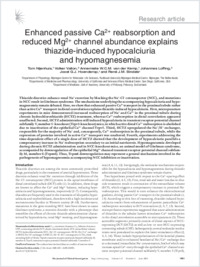Enhanced passive Ca²⁺ reabsorption and reduced Mg²⁺ channel abundance explains thiazide-induced hypocalciuria and hypomagnesemia
- Nijenhuis, Tom Department of Physiology, Nijmegen Centre for Molecular Life Sciences, Radboud University Nijmegen Medical Centre, Nijmegen, The Netherlands
- Vallon, Volker Departments of Medicine and Pharmacology, University of California and Veterans Affairs Medical Center, San Diego, California, USA
- Kemp van der, Annemiete W.C.M. Department of Physiology, Nijmegen Centre for Molecular Life Sciences, Radboud University Nijmegen Medical Centre, Nijmegen, The Netherlands
- Loffing, Johannes Department of Medicine, Unit of Anatomy, University of Fribourg, Fribourg, Switzerland
- Hoenderop, Joost G.J. Department of Physiology, Nijmegen Centre for Molecular Life Sciences, Radboud University Nijmegen Medical Centre, Nijmegen, The Netherlands
- Bindels, René J.M. Department of Physiology, Nijmegen Centre for Molecular Life Sciences, Radboud University Nijmegen Medical Centre, Nijmegen, The Netherlands
-
2005
Published in:
- The Journal of Clinical Investigation. - 2005, vol. 115(6), p. 1651
English
Thiazide diuretics enhance renal Na⁺ excretion by blocking the Na⁺-Cl⁻ cotransporter (NCC), and mutations in NCC result in Gitelman syndrome. The mechanisms underlying the accompanying hypocalciuria and hypomagnesemia remain debated. Here, we show that enhanced passive Ca²⁺ transport in the proximal tubule rather than active Ca²⁺ transport in distal convolution explains thiazide-induced hypocalciuria. First, micropuncture experiments in mice demonstrated increased reabsorption of Na⁺ and Ca²⁺ in the proximal tubule during chronic hydrochlorothiazide (HCTZ) treatment, whereas Ca²⁺ reabsorption in distal convolution appeared unaffected. Second, HCTZ administration still induced hypocalciuria in transient receptor potential channel subfamily V, member 5–knockout (Trpv5-knockout) mice, in which active distal Ca²⁺ reabsorption is abolished due to inactivation of the epithelial Ca²⁺ channel Trpv5. Third, HCTZ upregulated the Na⁺/H⁺ exchanger, responsible for the majority of Na⁺ and, consequently, Ca²⁺ reabsorption in the proximal tubule, while the expression of proteins involved in active Ca²⁺ transport was unaltered. Fourth, experiments addressing the time-dependent effect of a single dose of HCTZ showed that the development of hypocalciuria parallels a compensatory increase in Na⁺ reabsorption secondary to an initial natriuresis. Hypomagnesemia developed during chronic HCTZ administration and in NCC-knockout mice, an animal model of Gitelman syndrome, accompanied by downregulation of the epithelial Mg²⁺ channel transient receptor potential channel subfamily M, member 6 (Trpm6). Thus, Trpm6 downregulation may represent a general mechanism involved in the pathogenesis of hypomagnesemia accompanying NCC inhibition or inactivation.
- Faculty
- Faculté des sciences et de médecine
- Department
- Département de Médecine
- Language
-
- English
- Classification
- Biological sciences
- License
- License undefined
- Identifiers
-
- RERO DOC 5142
- DOI 10.1172/JCI24134
- Persistent URL
- https://folia.unifr.ch/unifr/documents/299906
Statistics
Document views: 129
File downloads:
- 1_loffing_epc.pdf: 212
